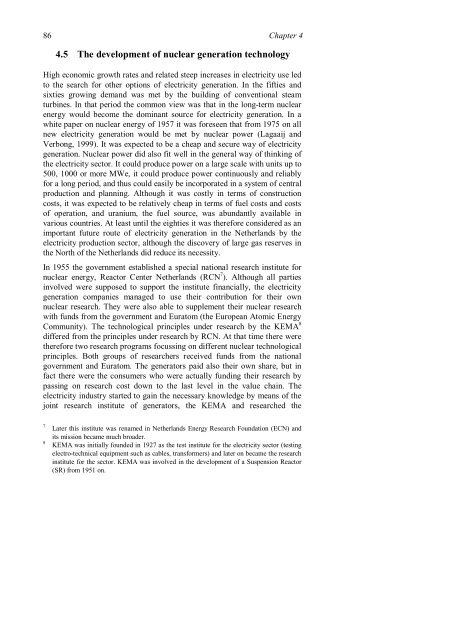Innovation and institutional change: the transition to a sustainable ...
Innovation and institutional change: the transition to a sustainable ...
Innovation and institutional change: the transition to a sustainable ...
Create successful ePaper yourself
Turn your PDF publications into a flip-book with our unique Google optimized e-Paper software.
86 Chapter 4<br />
4.5 The development of nuclear generation technology<br />
High economic growth rates <strong>and</strong> related steep increases in electricity use led<br />
<strong>to</strong> <strong>the</strong> search for o<strong>the</strong>r options of electricity generation. In <strong>the</strong> fifties <strong>and</strong><br />
sixties growing dem<strong>and</strong> was met by <strong>the</strong> building of conventional steam<br />
turbines. In that period <strong>the</strong> common view was that in <strong>the</strong> long-term nuclear<br />
energy would become <strong>the</strong> dominant source for electricity generation. In a<br />
white paper on nuclear energy of 1957 it was foreseen that from 1975 on all<br />
new electricity generation would be met by nuclear power (Lagaaij <strong>and</strong><br />
Verbong, 1999). It was expected <strong>to</strong> be a cheap <strong>and</strong> secure way of electricity<br />
generation. Nuclear power did also fit well in <strong>the</strong> general way of thinking of<br />
<strong>the</strong> electricity sec<strong>to</strong>r. It could produce power on a large scale with units up <strong>to</strong><br />
500, 1000 or more MWe, it could produce power continuously <strong>and</strong> reliably<br />
for a long period, <strong>and</strong> thus could easily be incorporated in a system of central<br />
production <strong>and</strong> planning. Although it was costly in terms of construction<br />
costs, it was expected <strong>to</strong> be relatively cheap in terms of fuel costs <strong>and</strong> costs<br />
of operation, <strong>and</strong> uranium, <strong>the</strong> fuel source, was abundantly available in<br />
various countries. At least until <strong>the</strong> eighties it was <strong>the</strong>refore considered as an<br />
important future route of electricity generation in <strong>the</strong> Ne<strong>the</strong>rl<strong>and</strong>s by <strong>the</strong><br />
electricity production sec<strong>to</strong>r, although <strong>the</strong> discovery of large gas reserves in<br />
<strong>the</strong> North of <strong>the</strong> Ne<strong>the</strong>rl<strong>and</strong>s did reduce its necessity.<br />
In 1955 <strong>the</strong> government established a special national research institute for<br />
nuclear energy, Reac<strong>to</strong>r Center Ne<strong>the</strong>rl<strong>and</strong>s (RCN 7 ). Although all parties<br />
involved were supposed <strong>to</strong> support <strong>the</strong> institute financially, <strong>the</strong> electricity<br />
generation companies managed <strong>to</strong> use <strong>the</strong>ir contribution for <strong>the</strong>ir own<br />
nuclear research. They were also able <strong>to</strong> supplement <strong>the</strong>ir nuclear research<br />
with funds from <strong>the</strong> government <strong>and</strong> Eura<strong>to</strong>m (<strong>the</strong> European A<strong>to</strong>mic Energy<br />
Community). The technological principles under research by <strong>the</strong> KEMA 8<br />
differed from <strong>the</strong> principles under research by RCN. At that time <strong>the</strong>re were<br />
<strong>the</strong>refore two research programs focussing on different nuclear technological<br />
principles. Both groups of researchers received funds from <strong>the</strong> national<br />
government <strong>and</strong> Eura<strong>to</strong>m. The genera<strong>to</strong>rs paid also <strong>the</strong>ir own share, but in<br />
fact <strong>the</strong>re were <strong>the</strong> consumers who were actually funding <strong>the</strong>ir research by<br />
passing on research cost down <strong>to</strong> <strong>the</strong> last level in <strong>the</strong> value chain. The<br />
electricity industry started <strong>to</strong> gain <strong>the</strong> necessary knowledge by means of <strong>the</strong><br />
joint research institute of genera<strong>to</strong>rs, <strong>the</strong> KEMA <strong>and</strong> researched <strong>the</strong><br />
7<br />
Later this institute was renamed in Ne<strong>the</strong>rl<strong>and</strong>s Energy Research Foundation (ECN) <strong>and</strong><br />
its mission became much broader.<br />
8<br />
KEMA was initially founded in 1927 as <strong>the</strong> test institute for <strong>the</strong> electricity sec<strong>to</strong>r (testing<br />
electro-technical equipment such as cables, transformers) <strong>and</strong> later on became <strong>the</strong> research<br />
institute for <strong>the</strong> sec<strong>to</strong>r. KEMA was involved in <strong>the</strong> development of a Suspension Reac<strong>to</strong>r<br />
(SR) from 1951 on.
















